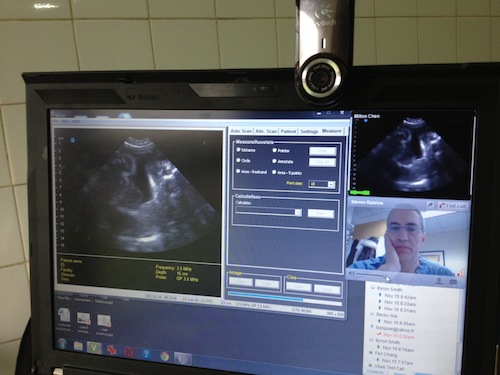The Accidental Social Enterprise: VSee’s unexpected foray into BoP health care
Milton Chen didn’t intend to become a social entrepreneur. His background is in computer science. After studying his PhD at Stanford and co-authoring the XMPP video standard used by Google Talk and Facebook Chat, he resolved to build a better video conferencing application.
“When I started out, people were complaining about the quality of Skype video,” he explains. “Drop outs, the video freezing up – so I just wanted to make a system that was better. And I felt that, if you have a conversation with someone, there’s no reason you need to go through some Google or Skype server where they have full access to your conversation, to track you and try to sell you advertising. It just felt a little bit evil. So I wanted a protocol which was always private by default.”
In 2008, Chen founded VSee, a video conferencing and screen share application that operates on a fraction of the bandwidth required by Skype, with the same level of video quality. He designed it with full-time end-to-end encryption.
Then something unexpected happened.
“As soon as we launched the company, we noticed that we had a lot of activity in developing countries,” he says. “Everybody there wants to use Skype, but because their bandwidth is not that great, they’re almost forced to use something else.”
Moreover, he noticed that many of VSee’s users were in the health care field. “Medical areas just started using this more and more, so we’ve been devoting more and more resources to telemedicine, combining VSee with some medical peripherals. We have projects in Nigeria, Kenya, Rwanda, Haiti, Egypt, Afghanistan, Pakistan, and Nepal – right now, half of our company revenue comes from telemedicine. And it’s pretty much been through word of mouth.”
VSee recently released the first iPad telehealth app that is FDA-registered and HIPAA-compliant. It also partners with other companies to offer a variety of telemedicine products, including:
- A stethoscope
- An otoscope
- An ultrasound
- An EKG
 All of these peripherals can be integrated with VSee’s videoconferencing tools. So a health care worker in a remote BoP clinic can listen to a patient’s lungs with a stethoscope (or do an ultrasound of her baby), and share the sounds and images in real time with other providers anywhere in the world. Providers even have the option of remote pan-tilt-zoom camera control, allowing doctors to perform visual diagnostic exams from across the globe.
All of these peripherals can be integrated with VSee’s videoconferencing tools. So a health care worker in a remote BoP clinic can listen to a patient’s lungs with a stethoscope (or do an ultrasound of her baby), and share the sounds and images in real time with other providers anywhere in the world. Providers even have the option of remote pan-tilt-zoom camera control, allowing doctors to perform visual diagnostic exams from across the globe.
(Left: Dr. Steve Ralston at Harvard views an ultrasound done in Gabon via VSee teleconference)
VSee offers these devices as part of its telemedicine kits, available through a subscription or as stand-alone purchases. The software can also integrate with other medical devices, as long as they have a video output.
These solutions have proven ideal for BoP customers – especially combined with the falling price of medical devices. “With ultrasounds, most people think about spending like $30,000,” Chen says. “But this machine is now like $4000. The otoscope is like $300. These peripherals are becoming very cheap now, so it’s actually pretty practical to set up a telemedicine clinic. And because the fully encrypted video is free always by default, we’re finding that it sort of matches their needs already.”
Though VSee serves many customers in the developed world, and many outside of the medical field, its thriving foray into BoP health care makes perfect sense. Yet social benefit wasn’t originally Chen’s intention.
“We are a for-profit start-up just like all these other startups that come out of Stanford and Silicon Valley,” he says. “So as a company, we have investors, and it is for money – it’s about making this into a huge company. Having said this, a number of our staff, before they joined VSee, had volunteered in refugee camps in Darfur and other places. I have actually worked in refugee camps in the Middle East, Africa, and Southeast Asia. So we are a for-profit, but we do a lot of pro bono work and make a lot of donations – if we see entities that can’t afford a subscription, we might just give them one for free. We essentially want to create a medical Skype for the world.”
- Categories
- Health Care, Technology
